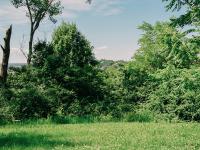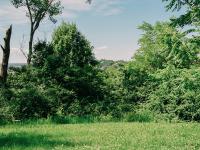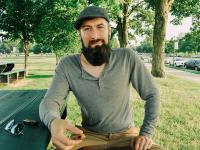During the fall, Kansas City-based artist Anthony Marcos Rea will use this exhibition space as an extension of his studio practice. The space will be in a constant state of change through December, revealing the evolution of the artist’s practice and his current Rocket Grant project “Where We No Longer Gather: Liberty Memorial, Penn Valley Park and Public Queer Looks” supported by Charlotte Street Foundation and KU Spencer Museum of Art.
Viewing his role akin to those of a facilitator, artist Anthony Marcos Rea provides the foundation of information and history in his works and leaves the rest up to the viewer. Rea’s formation of the artist as facilitator stems from his 14 year tenure working in community arts programs and youth development. It is within the Community Arts Profession where Rea has developed as an Artist; a place where he mines the past, explores the present and leaves the postulation of the future to the viewer. For the project “Where We No Longer Gather: Liberty Memorial, Penn Valley Park and Public Queer Looks,” Rea presents a series of photographs as a means to show Queer spaces in Kansas City – their histories and their current state. Through photography, an image depicting overgrown brush along a trail, Rea captures the abandoned; a place used to fulfill a desire of a past. Absent of an opinion to sway; like a true facilitator, Rea remains neutral. He leaves the viewer to question what happened to this once clearly, heavily used and vibrant scene. Is it being eradicated? If so, why? And where are those who once frequented at now? To better understand Rea's practice, we asked the artist to respond to a series of questions. The following are his responses:
What comes first – the medium or the message? Tell me a little about the work that will be on view.
I have been working in communities for 14 years and during that time I have been invested in community arts programs and youth development - it’s where I grew up professionally as an Artist so context and content is everything for me, my art making and pedagogy as a Community Arts Professional. Photography for me has always been a means to an end and never the driving force in the process even within the current project on view here titled “Where We No Longer Gather: Liberty Memorial, Penn Valley Park and Public Queer Looks”. This work on view here is a sampling of the imagery and project currently being produced. I selected two photographs; one being a portrait and the other something that I have been calling “monuments” of the brush and trails that aided in the construction of the public Queer space that was the Liberty Memorial and Penn Valley Park during the 1980’s.
What do you feel is your role as an artist?
I have always taken the role of “facilitator” in my work especially where the work is more community-based and centered like this current project. I offer a foundation of information and history for participants to take and leave the rest up to their own agency or experience to then share and transform it through shared knowledge and/or participation. The “big-picture” question here is “Where are our public Queer spaces and what happened or rather why have they been eradicated?” It’s a question that is both valid and necessary especially now as the city attempts to transform and its narrative and one important for any Queer person to ask as our community and community spaces remain under siege still today in 2016.
What influences your practice/works?
My teaching and community-based work has influenced much of my art making practice. To be charged with the responsibility to lead, or facilitate or even organize a group of people around something requires you to be heavily aware and informed with as much of the content as possible. So much so, you can easily translate that information to others who can quickly understand and still be able to create something or engage with the material in a meaningful and relevant way. Because of this, I have become a better researcher and more importantly a better Artist when working and collaborating with others.
Who are the other artists you look to for inspiration? And what about their works do you like?
In regards to Artists, I am most inspired by the works of Carrie Mae Weems and her use of image and text; the site-specific works of Maria Gaspar; Theaster Gates community development and agency practices; the installation works of LaToya Ruby Frazier; the writings on Queer futurism by Jose Luis Esteban; and finally the photography of Doug Ischar who photographed the Queer community that gathered in Chicago’s Lincoln Park in an area what the larger community refers to as “Belmont Rocks."
What other writings do you recommend reading to have a better understanding of your artworks and your art practice/process?
The educator and writing of bell hooks. Her voice and thinking was a very influential source for me early on and provided me with a vocabulary to begin communicating and speak about the world I grew up in and was navigating as a Queer Latino Artist of Color. There is a book that I hope to check out soon Queer (In)justice by Joey L. Mogul that may relate easily to the history of KC’s Queer community and lend itself to the discussion around the removal of the public Queer space that made up the Liberty Memorial and Penn Valley Park.
For more information on the Anthony Marcos Rae, visit www.anthonymarcosrea.com.



